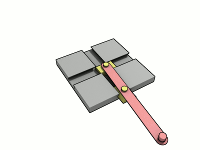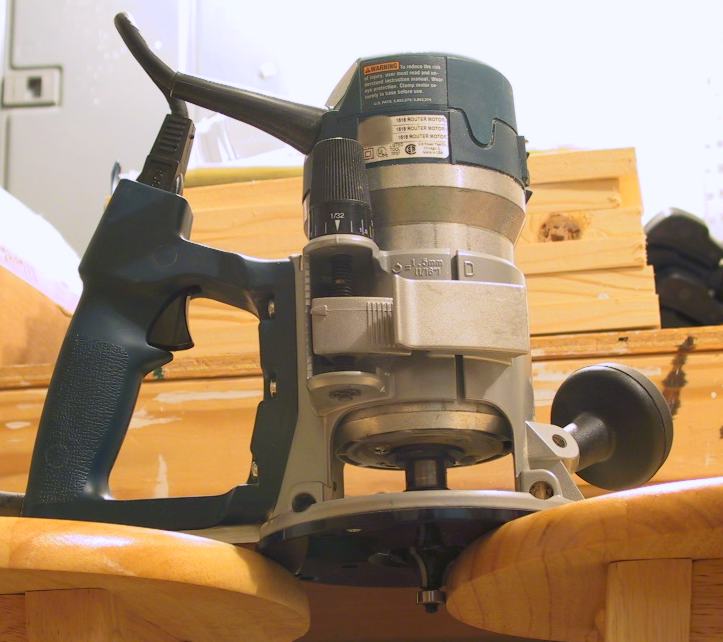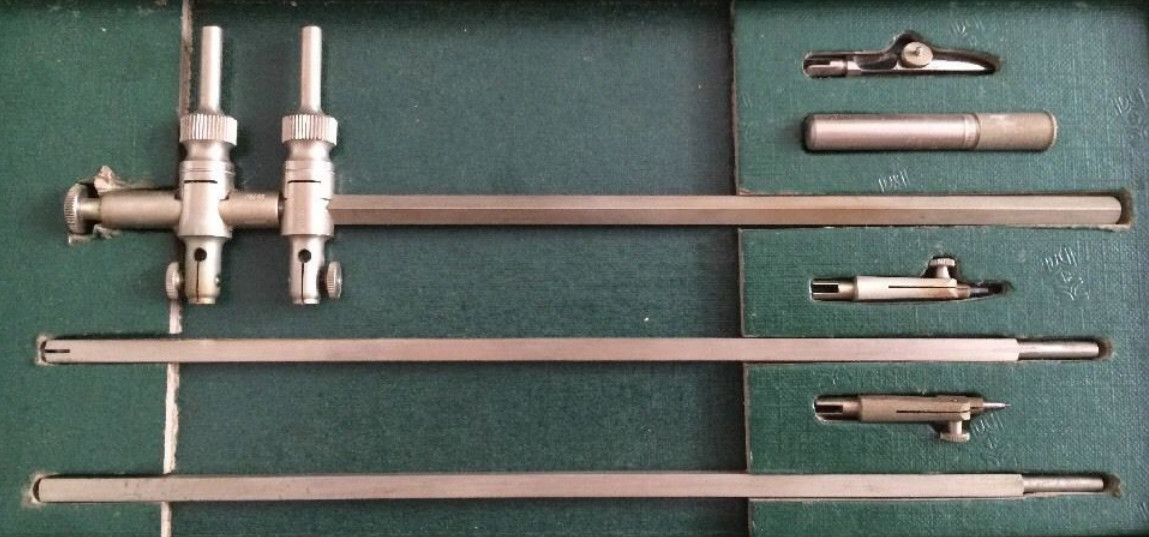|
Trammel Of Archimedes
A trammel of Archimedes is a mechanism that generates the shape of an ellipse. () It consists of two shuttles which are confined ("trammeled") to perpendicular channels or rails and a rod which is attached to the shuttles by pivots at fixed positions along the rod. As the shuttles move back and forth, each along its channel, all points on the rod move in elliptical paths. The motion of the rod is termed elliptical motion. The semi-axes ''a'' and ''b'' of the ellipses have lengths equal to the distances from the point on the rod to each of the two pivots. The straight lines described by the pivots are special cases of an ellipse, where the length of one axis is twice the distance between the pivots and that of the other is zero. All points on a circle with a diameter defined by the two pivots reciprocate in such straight lines. This circle corresponds to the smaller circle in a Tusi couple. The point midway between the pivots orbits in a circle around the point where the chan ... [...More Info...] [...Related Items...] OR: [Wikipedia] [Google] [Baidu] |
Trammel Of Archimedes Small White
Trammel or Trammelsor Trammell may refer to: Places * Trammel, Virginia * Trammels, Texas, United States People with the name * Allen Trammell (born 1942), American football player * Joel Trammell (born 1965), American businessman * Trammell, both a surname and a given name Other uses * Trammel (fishing net) * Trammel, a tool for restraining a horse's ambling * Trammel hook * Trammel of Archimedes, a tool for drawing ellipses * Trammel points or trammels, metal points with clamping apparatus used to construct a beam compass A beam compass is a compass with a beam and sliding sockets or cursors for drawing and dividing circles larger than those made by a regular pair of compasses. The instrument can be as a whole, or made on the spot with individual sockets (called ... * '' Trammel v. United States'' {{disambiguation ... [...More Info...] [...Related Items...] OR: [Wikipedia] [Google] [Baidu] |
Wood Router
The router is a power tool with a flat base and a rotating blade extending past the base. The spindle may be driven by an electric motor or by a pneumatic motor. It routs (hollows out) an area in hard material, such as wood or plastic. Routers are used most often in woodworking, especially cabinetry. They may be handheld or affixed to router tables. Some woodworkers consider the router one of the most versatile power tools. There is also a traditional hand tool known as a router plane, a form of hand plane with a broad base and a narrow blade projecting well beyond the base plate. CNC wood routers add the advantages of computer numerical control (CNC). The laminate trimmer is a smaller, lighter version of the router. Although it is designed for trimming laminates, it can also be used for smaller general routing work. Rotary tools can also be used similarly to routers with the right bits and accessories (such as plastic router bases). History Before power routers ... [...More Info...] [...Related Items...] OR: [Wikipedia] [Google] [Baidu] |
Traditional Toys
A tradition is a belief or behavior (folk custom) passed down within a group or society with symbolic meaning or special significance with origins in the past. A component of cultural expressions and folklore, common examples include holidays or impractical but socially meaningful clothes (like lawyers' wigs or military officers' spurs), but the idea has also been applied to social norms such as greetings. Traditions can persist and evolve for thousands of years—the word ''tradition'' itself derives from the Latin ''tradere'' literally meaning to transmit, to hand over, to give for safekeeping. While it is commonly assumed that traditions have an ancient history, many traditions have been invented on purpose, whether that be political or cultural, over short periods of time. Various academic disciplines also use the word in a variety of ways. The phrase "according to tradition", or "by tradition", usually means that whatever information follows is known only by oral tradition ... [...More Info...] [...Related Items...] OR: [Wikipedia] [Google] [Baidu] |
Mathologer
Burkard Polster (born 26 February 1965 in Würzburg) is a German mathematician who runs and presents the ''Mathologer'' channel on YouTube. Polster earned a doctorate from the University of Erlangen–Nuremberg in 1993 under the supervision of Karl Strambach. He works as an associate professor of mathematics at Monash University in Melbourne, Australia. Other universities that Polster has been affiliated with, before joining Monash in 2000, include the University of Würzburg, University at Albany, University of Kiel, University of California, Berkeley, University of Canterbury, and University of Adelaide. Polster's research involves topics in geometry, recreational mathematics, and the mathematics of everyday life, including how to tie shoelaces Shoelaces, also called shoestrings (US English) or bootlaces (UK English), are a system commonly used to secure shoes, boots, and other footwear. They typically consist of a pair of strings or cords, one for each shoe, finished off ... [...More Info...] [...Related Items...] OR: [Wikipedia] [Google] [Baidu] |
Lego
Lego ( , ; stylized as LEGO) is a line of plastic construction toys that are manufactured by The Lego Group, a privately held company based in Billund, Denmark. The company's flagship product, Lego, consists of variously colored interlocking plastic bricks accompanying an array of gears, figurines called minifigures, and various other parts. Lego pieces can be assembled and connected in many ways to construct objects, including vehicles, buildings, and working robots. Anything constructed can be taken apart again, and the pieces reused to make new things. The Lego Group began manufacturing the interlocking toy bricks in 1949. Movies, games, competitions and eight Legoland amusement parks have been developed under the brand. , 600 billion Lego parts had been produced. History The Lego Group began in the workshop of Ole Kirk Christiansen (1891–1958), a carpenter from Billund, Denmark, who began making wooden toys in 1932. In 1934, his company came to be cal ... [...More Info...] [...Related Items...] OR: [Wikipedia] [Google] [Baidu] |
Scott Russell Linkage
A Scott Russell linkage is a linkage which translates linear motion through a right angle. The linkage is named after John Scott Russell (1808–1882), although watchmaker William Freemantle had already patented it in 1803. A different form of the linkage has been used in a front-wheel-drive vehicle with solid rear axle to control lateral movement, and with a flexing elastomeric connection instead of the rolling or sliding connection. The linkage does not share the disadvantages of the asymmetric Panhard rod, and although more compact than Watt's linkage, it has all the forces concentrated in one link. Construction and related linkages The linkage is composed of two links. One link is double the size of the other, and is connected to the smaller link by its midpoint. One of the ends is then connected to something that can generate linear motion, such as a rolling Rolling is a type of motion that combines rotation (commonly, of an axially symmetric object) and transl ... [...More Info...] [...Related Items...] OR: [Wikipedia] [Google] [Baidu] |
Useless Machine
A useless machine or useless box is a device which has a function but its direct purpose is deliberately unknown. The best-known useless machines are those inspired by Marvin Minsky's design, in which the device's sole function is to switch itself off by operating its own "off" switch. Such machines were popularised commercially in the 1960s, sold as an amusing engineering hack (term), hack, or as a joke. More elaborate devices and some novelty toy, novelty toys, which have a more obvious function or entertainment value, have been based on these simple useless machines. History The Italian artist Bruno Munari began building "useless machines" (''macchine inutili'') in the 1930s. He was a "third generation" Futurist and did not share the first generation's boundless enthusiasm for technology, but sought to counter the threats of a world under machine rule by building machines that were artistic and unproductive. The version of the useless machine that became famous in informatio ... [...More Info...] [...Related Items...] OR: [Wikipedia] [Google] [Baidu] |
Hypotrochoid
In geometry, a hypotrochoid is a roulette traced by a point attached to a circle of radius rolling around the inside of a fixed circle of radius , where the point is a distance from the center of the interior circle. The parametric equations for a hypotrochoid are: :\begin & x (\theta) = (R - r)\cos\theta + d\cos\left(\theta\right) \\ & y (\theta) = (R - r)\sin\theta - d\sin\left(\theta\right) \end where is the angle formed by the horizontal and the center of the rolling circle (these are not polar equations because is not the polar angle). When measured in radian, takes values from 0 to 2 \pi \times \tfrac (where is least common multiple). Special cases include the hypocycloid with and the ellipse with and . The eccentricity of the ellipse is :e=\frac becoming 1 when d=r (see Tusi couple). The classic Spirograph toy traces out hypotrochoid and epitrochoid curves. Hypotrochoids describe the support of the eigenvalues of some random matrices with cyclic correlation ... [...More Info...] [...Related Items...] OR: [Wikipedia] [Google] [Baidu] |
Hypocycloid
In geometry, a hypocycloid is a special plane curve generated by the trace of a fixed point on a small circle that rolls within a larger circle. As the radius of the larger circle is increased, the hypocycloid becomes more like the cycloid created by rolling a circle on a line. Properties If the smaller circle has radius , and the larger circle has radius , then the parametric equations for the curve can be given by either: :\begin & x (\theta) = (R - r) \cos \theta + r \cos \left(\frac \theta \right) \\ & y (\theta) = (R - r) \sin \theta - r \sin \left( \frac \theta \right) \end or: :\begin & x (\theta) = r (k - 1) \cos \theta + r \cos \left( (k - 1) \theta \right) \\ & y (\theta) = r (k - 1) \sin \theta - r \sin \left( (k - 1) \theta \right) \end If is an integer, then the curve is closed, and has cusps (i.e., sharp corners, where the curve is not differentiable). Specially for the curve is a straight line and the circles are called Cardano circles. Girolamo Cardano ... [...More Info...] [...Related Items...] OR: [Wikipedia] [Google] [Baidu] |
John Farey Jr
John Farey Jr. (20 March 1791 – 17 July 1851) was an English mechanical engineering, consulting engineer and patent agent, known for his pioneering contributions in the field of mechanical engineering.Alec Skempton.Farey, Jr., John" in: ''A Biographical Dictionary of Civil Engineers in Great Britain and Ireland: 1500–1830.'' 2002. p. 223-224 As consulting engineer Farey worked for many well-known inventors of the later Industrial Revolution, and was a witness to a number of parliamentary enquiries, inquests and court cases, and on occasion acted as an arbitrator. He was polymathic in his interests and contributed text and drawings to a number of periodicals and encyclopaedias. Farey is also remembered as the first English inventor of the ellipsograph, an instrument used by draughtsmen to inscribe ellipses. Biography Youth and education Farey was the eldest son of John Farey Sr. (1766–1826), the geologist, and Sophia Hubert (1770–1830). He was the older brother of J ... [...More Info...] [...Related Items...] OR: [Wikipedia] [Google] [Baidu] |
Bourke Engine
The Bourke engine was an attempt by Russell Bourke, in the 1920s, to improve the two-stroke internal combustion engine. Despite finishing his design and building several working engines, the onset of World War II, lack of test results, and the poor health of his wife compounded to prevent his engine from ever coming successfully to market. The main claimed virtues of the design are that it has only two moving parts, is lightweight, has two power pulses per revolution, and does not need oil mixed into the fuel. The Bourke engine is basically a two-stroke design, with one horizontally opposed piston assembly using two pistons that move in the same direction at the same time, so that their operations are 180 degrees out of phase. The pistons are connected to a Scotch Yoke mechanism in place of the more usual crankshaft mechanism, thus the piston acceleration is perfectly sinusoidal. This causes the pistons to spend more time at top dead center than conventional engines. The in ... [...More Info...] [...Related Items...] OR: [Wikipedia] [Google] [Baidu] |
Beam Compass
A beam compass is a compass with a beam and sliding sockets or cursors for drawing and dividing circles larger than those made by a regular pair of compasses. The instrument can be as a whole, or made on the spot with individual sockets (called trammel points) and any suitable beam. Draftsman's beam compass A draftsman's beam compass consists of a set of points and holders, mounted on a plated brass, aluminum, or German 'silver' rod. One end is generally locked down at the end of the rod, while the other has both rough and fine adjustments, though some are opposite in construction. The locked tip holder consists of a needle, for the centre of the radius, and the other holds either a lead clutch, or an inking nib. There are older variants which use a wooden beam. Another similar type is a Machinist or Engineers beam compass, which uses scribing points only, similar to ones used by woodworkers, except that its fine adjustment is generally more refined. These beam compasses can ... [...More Info...] [...Related Items...] OR: [Wikipedia] [Google] [Baidu] |








